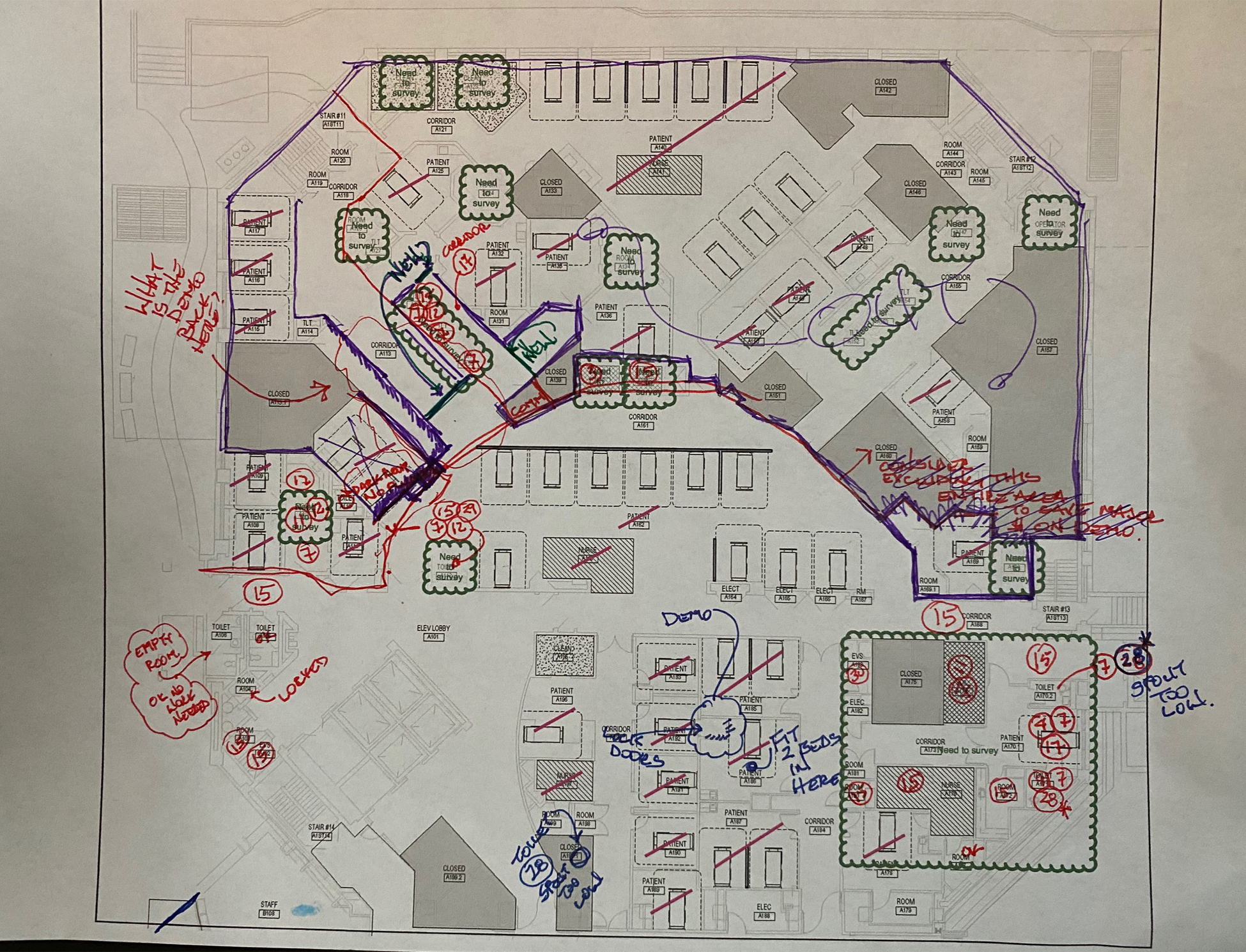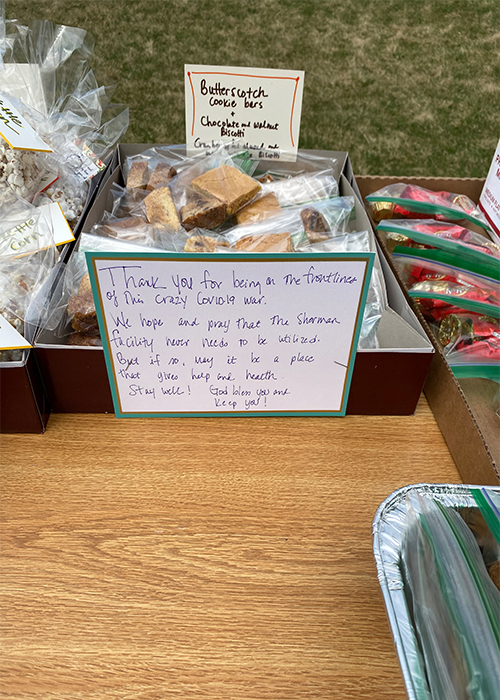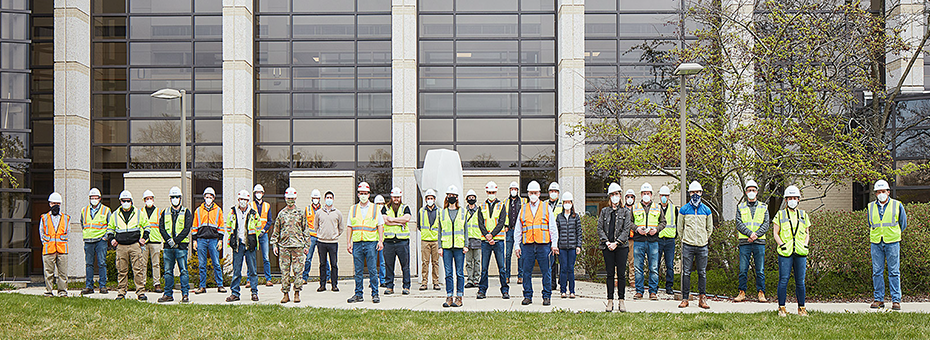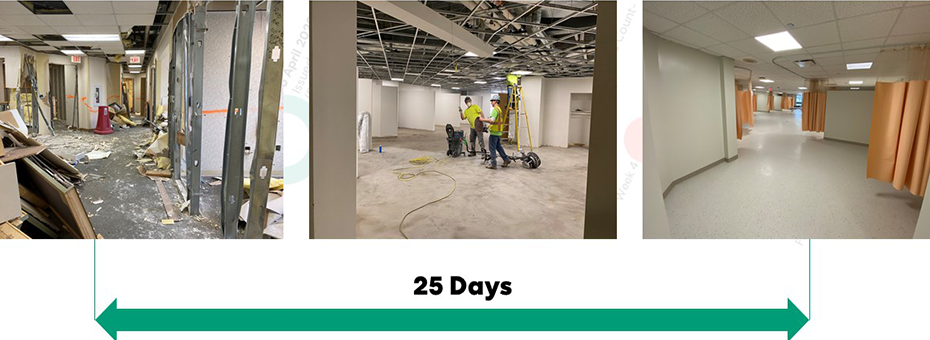Imagine being given the incredibly challenging and rewarding task of delivering both the design and construction of a 274 bed, 100,000 square foot healthcare renovation in 25 days in the midst of a pandemic. Now consider achieving that goal with no injuries, four percent earlier than expected, and nine percent under budget.
In late March of last year, there was a rapid increase in the number and severity of people infected with COVID-19, and there was a real concern that we would not have sufficient The project might sound stressful, and it was, but every person on the team was professional, focused, and determined; and we exceeded everyone’s expectations. healthcare facilities to treat everyone infected, giving rise to the need for alternate care facilities (ACF’s) in targeted areas across the country.
Given the need for additional space for patient care, the project team was designing, planning, and building the facility simultaneously—as-built drawings were available on the first day of construction. The project was completed in April 2020 as COVID-19 was spreading across the United States.
It might sound stressful, and it was, but every person on the team was professional, focused, and determined; and we exceeded everyone’s expectations.
The ACF site was a 250,000 square feet outpatient facility that had been largely abandoned for the previous 10 years. There was water damage, mold, and we were not even sure the existing elevators and building systems would function. Despite the conditions, we delivered all the operational requirements and nine more beds than the 265-bed target.
Maybe the most remarkable thing is that, despite the obstacles and exhausting pace, we all thought, “That was crazy! But I would love to work with that team again.” That reality is what led us here. How can we help others apply what we learned to any project and recreate the conditions that allowed us to do great things? We found six things that were key to success.

Create Motivation With a Mission
What we did: The mission of “Save lives by delivering as many beds as possible in the shortest time possible” was the clear motivator for our team. The critical work we were doing kept the team focused, engaged, and willing to deal with hardship and allowed us to be tolerant of missteps and open-minded in addressing challenges.
What you can do: Every project is built for a reason. Define a clear motive and share it with the entire team. Post it for everyone to see, repeat it often, and create that sense of purpose. That purpose will focus the team when things get tough.
Identify and Empower a Leadership Team
What we did: At the beginning, each party took ownership by identifying their leadership team, clearly defining each leader’s role, and communicating that to everyone working on the project. We all knew who to direct questions to, who was responsible for various aspects of the work, and who was empowered to make decisions. So, when questions arose, we could quickly and decisively make decisions to keep the work moving forward. The team leaders had the ability, confidence, and authority to make decisions while keeping the project requirements in mind: finish on time, stay under budget, and meet the changing owner criteria.
What you can do: Clearly identify the leadership team, their roles, and their responsibilities. Make sure the entire team knows who is empowered to make decisions. Establish ground rules around decision-making so everyone knows the players, the process, and the parameters.
Build a Culture of Appreciation
What we did: We were working under immense pressure, and the pace was relentless. Under these conditions, it felt natural to go out of your way to thank people and acknowledge their efforts. We provided lunches and dinners and t-shirts and hats for the people involved. The owner presented certificates of appreciation to the staff, and the community even baked treats and dropped them off at the job site for everyone. And as much as anything, we said, ‘Thanks’ to one another, a lot. Simple acts of appreciation motivate and inspire people to do their best.

What you can do: Take the time to recognize every member of the team regularly for their efforts. Be specific and sincere. Create an appreciation program for the project that recognizes everyone’s efforts. The impact a meal or t-shirt has on morale and good will cannot be overestimated.
Create a Trusting Environment
What we did: Our team was assembled and organized quickly. A few project leaders had worked together in the past and built strong, trusting relationships. This respect and trust were on display from the first day, set the tone for the entire project, and quickly spread to the rest of the team. Creating a trusting environment can take months but, like everything on this project, was compressed; trust built quickly among the team as each person delivered on their promises daily.
The quickest way to build trust is to make promises and keep them. What you can do: Build a leadership team that trusts one another by creating an environment where people feel safe to make promises and accept responsibility when they have a misstep. The quickest way to build trust is to make promises and keep them. Doing so creates an environment of ownership and responsibility and helps shift the culture from one of “holding people accountable” to a culture of “being responsible.” Agree, as a team, to the meaning of being responsible and hold people to that standard. If you make a mistake, own it! Do not deflect or play the victim. Finally, do not attack people that make mistakes. Seek to understand what happened and how you can work together to prevent this from happening again. Develop an environment where everyone is comfortable speaking up when they see a problem and remember that everyone has a role to play in making this happen.
Communicate Early and Often
What we did: Because design, construction and project conditions were constantly changing, the entire team over-communicated, and used every available medium: e-mail, text, phone, instant message, and in-person to connect and share information. This kept everyone informed. There were some constants that brought clarity: morning staff huddles kept staff focused for the day and up-to-date on current design documents; mid-day project meetings appraised the owner of the status of design and construction; afternoon field huddles with superintendents and foremen set the stage for third shift work; late-night design team check-ins updated design status and set goals for the following day. This multitude of communications contributed to our ability to make decisions, anticipate coming obstacles and course-correct in the field.
What you can do: As early as possible, create a communication plan. Define how you will share information and when you will use the various forms of communication at your disposal. Determine what meetings are needed along with who will be there, the expected outcomes of those meetings, and the ground rules. Do not make assumptions about how communication will happen and be sure to take the time to establish clear expectations.
Enable and Encourage Adaptation
What we did: Time was of the essence and everyone knew it, so we held to a “Plan, Do, Check, Adjust” approach to the work. The team had a willingness to explore multiple options and our approach allowed us all to adjust to the challenges that emerged. Every team member was willing to pivot as information came to light and as the resulting decisions were made.
It was clear that the design team would need to be on site every day to adapt the design to existing conditions. Similarly, regular owner presence on site was necessary to help with inspections, reviews, and decision-making. Turner utilized national resources to expedite work and provide expertise as the project evolved. Aside from a few consistent issues (schedule, budget, bed count and life safety), every option was on the table for this project.
What you can do: Create a Plan, Do, Check, Adjust approach that will allow your team to push the boundaries. Put everything on the table, only hold your ground on what really matters and communicate those non-negotiables to your team. Create an environment where the first answer is, “yes” or “yes if…” and “no” isn’t the first answer when someone tries something new.
This was, undeniably, an intense and stressful project; but for the team, it was the most personally and professionally fulfilling project we have worked on. The sense of community, friendship and personal connection to the entire team is something that truly appreciated. There was trust and the solidarity borne out of commitment to the mission that enabled all of us to set aside our normal ‘positions’ and ways of working to deliver the impossible.






